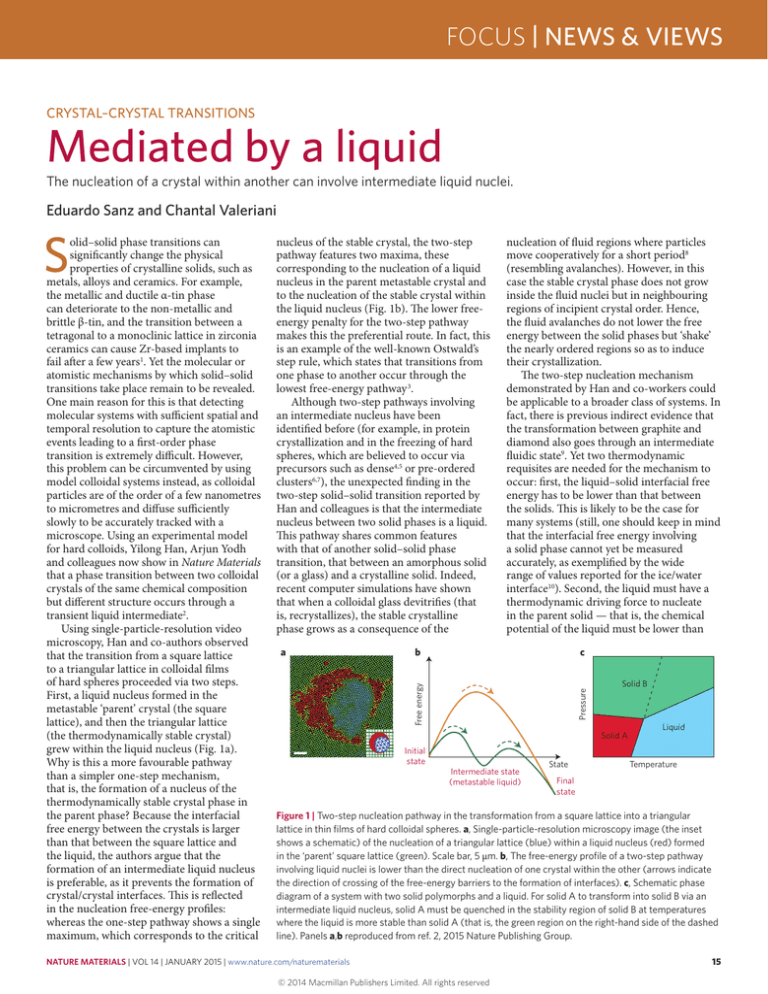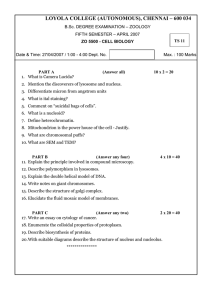
FOCUS | NEWS & VIEWS
CRYSTAL–CRYSTAL TRANSITIONS
Mediated by a liquid
The nucleation of a crystal within another can involve intermediate liquid nuclei.
Eduardo Sanz and Chantal Valeriani
nucleus of the stable crystal, the two-step
pathway features two maxima, these
corresponding to the nucleation of a liquid
nucleus in the parent metastable crystal and
to the nucleation of the stable crystal within
the liquid nucleus (Fig. 1b). The lower freeenergy penalty for the two-step pathway
makes this the preferential route. In fact, this
is an example of the well-known Ostwald’s
step rule, which states that transitions from
one phase to another occur through the
lowest free-energy pathway 3.
Although two-step pathways involving
an intermediate nucleus have been
identified before (for example, in protein
crystallization and in the freezing of hard
spheres, which are believed to occur via
precursors such as dense4,5 or pre-ordered
clusters6,7), the unexpected finding in the
two-step solid–solid transition reported by
Han and colleagues is that the intermediate
nucleus between two solid phases is a liquid.
This pathway shares common features
with that of another solid–solid phase
transition, that between an amorphous solid
(or a glass) and a crystalline solid. Indeed,
recent computer simulations have shown
that when a colloidal glass devitrifies (that
is, recrystallizes), the stable crystalline
phase grows as a consequence of the
a
nucleation of fluid regions where particles
move cooperatively for a short period8
(resembling avalanches). However, in this
case the stable crystal phase does not grow
inside the fluid nuclei but in neighbouring
regions of incipient crystal order. Hence,
the fluid avalanches do not lower the free
energy between the solid phases but ‘shake’
the nearly ordered regions so as to induce
their crystallization.
The two-step nucleation mechanism
demonstrated by Han and co-workers could
be applicable to a broader class of systems. In
fact, there is previous indirect evidence that
the transformation between graphite and
diamond also goes through an intermediate
fluidic state9. Yet two thermodynamic
requisites are needed for the mechanism to
occur: first, the liquid–solid interfacial free
energy has to be lower than that between
the solids. This is likely to be the case for
many systems (still, one should keep in mind
that the interfacial free energy involving
a solid phase cannot yet be measured
accurately, as exemplified by the wide
range of values reported for the ice/water
interface10). Second, the liquid must have a
thermodynamic driving force to nucleate
in the parent solid — that is, the chemical
potential of the liquid must be lower than
b
c
Pressure
Free energy
S
olid–solid phase transitions can
significantly change the physical
properties of crystalline solids, such as
metals, alloys and ceramics. For example,
the metallic and ductile α-tin phase
can deteriorate to the non-metallic and
brittle β-tin, and the transition between a
tetragonal to a monoclinic lattice in zirconia
ceramics can cause Zr-based implants to
fail after a few years1. Yet the molecular or
atomistic mechanisms by which solid–solid
transitions take place remain to be revealed.
One main reason for this is that detecting
molecular systems with sufficient spatial and
temporal resolution to capture the atomistic
events leading to a first-order phase
transition is extremely difficult. However,
this problem can be circumvented by using
model colloidal systems instead, as colloidal
particles are of the order of a few nanometres
to micrometres and diffuse sufficiently
slowly to be accurately tracked with a
microscope. Using an experimental model
for hard colloids, Yilong Han, Arjun Yodh
and colleagues now show in Nature Materials
that a phase transition between two colloidal
crystals of the same chemical composition
but different structure occurs through a
transient liquid intermediate2.
Using single-particle-resolution video
microscopy, Han and co-authors observed
that the transition from a square lattice
to a triangular lattice in colloidal films
of hard spheres proceeded via two steps.
First, a liquid nucleus formed in the
metastable ‘parent’ crystal (the square
lattice), and then the triangular lattice
(the thermodynamically stable crystal)
grew within the liquid nucleus (Fig. 1a).
Why is this a more favourable pathway
than a simpler one-step mechanism,
that is, the formation of a nucleus of the
thermodynamically stable crystal phase in
the parent phase? Because the interfacial
free energy between the crystals is larger
than that between the square lattice and
the liquid, the authors argue that the
formation of an intermediate liquid nucleus
is preferable, as it prevents the formation of
crystal/crystal interfaces. This is reflected
in the nucleation free-energy profiles:
whereas the one-step pathway shows a single
maximum, which corresponds to the critical
Solid B
Solid A
Initial
state
Intermediate state
(metastable liquid)
State
Liquid
Temperature
Final
state
Figure 1 | Two-step nucleation pathway in the transformation from a square lattice into a triangular
lattice in thin films of hard colloidal spheres. a, Single-particle-resolution microscopy image (the inset
shows a schematic) of the nucleation of a triangular lattice (blue) within a liquid nucleus (red) formed
in the ‘parent’ square lattice (green). Scale bar, 5 μm. b, The free-energy profile of a two-step pathway
involving liquid nuclei is lower than the direct nucleation of one crystal within the other (arrows indicate
the direction of crossing of the free-energy barriers to the formation of interfaces). c, Schematic phase
diagram of a system with two solid polymorphs and a liquid. For solid A to transform into solid B via an
intermediate liquid nucleus, solid A must be quenched in the stability region of solid B at temperatures
where the liquid is more stable than solid A (that is, the green region on the right-hand side of the dashed
line). Panels a,b reproduced from ref. 2, 2015 Nature Publishing Group.
NATURE MATERIALS | VOL 14 | JANUARY 2015 | www.nature.com/naturematerials
© 2014 Macmillan Publishers Limited. All rights reserved
15
NEWS & VIEWS | FOCUS
that of the parent solid). This condition
may not be satisfied generally because the
chemical potential of the liquid depends
on thermodynamic conditions (Fig. 1c).
If the liquid is less stable than the parent
solid (that is, if it has a higher chemical
potential), the solid–solid transition would
most likely occur through a diffusionless
martensitic route.
Experiments and computer simulations
of model colloidal particles are ideal for
investigating whether solid–solid transition
pathways depend on thermodynamic
conditions, and can also provide clues on
phase-transition mechanisms in atomic
or molecular systems11,12. Still, accurate
knowledge of the equilibrium phase diagram
MATERIAL WITNESS
16
is required, which is difficult to achieve
experimentally. In this respect, simulations
can provide useful guidance13 — in fact,
the stability range for the triangular and
square lattices had been predicted earlier 14.
With advances in particle synthesis, video
microscopy and the characterization
of model colloidal systems, one would
expect that the effects of constant pressure,
particle asymmetry and particle softness —
conditions that are generally more
realistic — will soon be evaluated.
❐
Eduardo Sanz and Chantal Valeriani are in the
Departmento de Química-física I, Universidad
Complutense de Madrid, 28040 Madrid, Spain.
e-mail: esa01@quim.ucm.es
References
1. Shen, J. Z. & Kosmač, T. (eds) Advanced Ceramics for Dentistry
(Elsevier, 2014).
2. Peng, Y. et al. Nature Mater. 14, 101–108 (2015).
3. Ostwald, W. Z. Physik. Chem. 22, 289–330 (1897).
4. ten Wolde, P. R. & Frenkel, D. Science 277, 1975–1978 (1997).
5. Schilling, T., Schope, H. J., Oettel, M., Opletal, G. & Snook, I.
Phys. Rev. Lett. 105, 025701 (2010).
6. Kawasaki, T. & Tanaka, H. Proc. Natl Acad. Sci. USA
107, 14036–14041 (2010).
7. Tan, P., Xu, N. & Xu, L. Nature Phys. 10, 73–79 (2014).
8. Sanz, E. et al. Proc. Natl Acad. Sci. USA 111, 75–80 (2014).
9. Shekar, N. C. & Rajan, K. G. Bull. Mater. Sci.
24, 1–21 (2001).
10. Prupacher, H. R. J. Atmosph. Sci. 52, 1924–1933 (1995).
11. Khaliullin, R. Z., Eshet, H., Kühne, T. D., Behler, J. &
Parrinello, M. Nature Mater. 10, 693–697 (2011).
12. Sanz, E. et al. J. Am. Chem. Soc. 135, 15008–15017 (2013).
13. Vega, C., Sanz, E., Abascal, J. L. F. & Noya, E. G.
J. Phys. Condens. Matter 20, 153101 (2008).
14. Fortini, A. & Dijkstra, M. J. Phys. Condens. Matter
18, L371–L378 (2006).
THE FINAL CUT
Origami — the folding of flat sheets —
has been a well-advertised approach
to engineering structures with diverse
properties that can be efficiently and
easily collapsed and unfolded1. But
there is another constructive paper art
in Far East Asia that has received less
attention: kirigami, in which paper
is cut into intricate patterns. This
approach often involves folding too:
the archetypal kirigami form is a scene,
often a building, made from strips and
facets that emerge from the hinge of a
folded sheet.
Although kirigami is essentially
of Japanese origin, it has long been
familiar throughout the world in the
form of the snowflake decoration
made by folding and nicking a
sheet (a method sadly apt to yield
snowflakes with four-fold rather
than six-fold symmetry). Paper-cut
snowflakes — simply outlines rather
than genuine kirigami — featured
in one of the first serious studies of
their forms, Cloud Crystals (1864)
by the keen-eyed American amateur
Frances Chickering.
Kirigami has, however, so far
enjoyed scant attention in materials
science — among rare examples,
there has been interest in applying its
methods at the nanoscale to graphene
to alter its mechanical properties2,3.
Now, Cho et al. have attempted to
give kirigami engineering a more
systematic conceptual basis4. They
describe a general approach for
enabling a sheet of flexible material
to adopt an arbitrary geometry by
reverse-engineering the system of
cuts needed to attain it. No folding is
employed here: the deformations of
the sheet come solely from making a
series of slits that fragment the sheet
into smaller blocks connected at their
corners, which will then rotate under
tension so that the blocks open out
into an expanded network.
In general these blocks might be
squares or triangles. Their rotation
depends on leaving a small amount of
material at the ends of the cuts, and on
these hinges being sufficiently flexible
to deform while strong enough not
to simply tear. The design parameters
here are material-dependent: the
researchers demonstrate their ideas
with elastomeric sheets, but say
that metals might be used if the
hinge stresses can be kept below the
yield strength.
The amount of expansion of the
fabric (shown here to reach up to
800%) can be adjusted by imposing
a fractal hierarchy on the cuts. Each
square block, say, can be divided
into smaller squares and so forth. By
varying the degree of the hierarchy
from place to place, the sheet can
adopt all kinds of curved grid-like
geometry, including non-Euclidean
ones. As a demonstration, Cho et al.
cut a silicone rubber sheet, coated with
a layer of carbon nanotubes to make
it electrically conducting, so that it
PHILIP BALL
can be wrapped around a baseball
without wrinkles while retaining the
connectivity that enables it to wire
up a light-emitting diode across the
ball’s surface.
There is an echo here of the reverse
problem of projecting the Earth
onto a flat world map. Cho et al.’s
method of covering a sphere with a
sheet is certainly more elegant than
the ungainly Goode homolosine
cartographic projection, with its
awkward rents in the oceans — but
at the considerable cost, perhaps, of
fragmenting the surface into countless
little pieces.
❐
References
1. Schenk, M. & Guest, S. D. in Origami 5: Fifth
International Meeting of Origami Science, Mathematics,
and Education (eds Wang-Iverson, P., Lang, R. J. &
Yim, M.) 293–305 (CRC Press, 2011).
2. Blees, M., Rose, P., Barnard, A., Roberts, S. &
McEuen, P. L. Bull. Am. Phys. Soc.
59, abstr. L30.00011 (2014).
3. Qi, Z., Park, H. S. & Campbell, D. K. Preprint at
http://arxiv.org/abs/1407.8113 (2014).
4. Cho, Y. et al. Proc. Natl Acad. Sci. USA http://dx.doi.org/
10.1073/pnas.1417276111 (2014).
NATURE MATERIALS | VOL 14 | JANUARY 2015 | www.nature.com/naturematerials
© 2014 Macmillan Publishers Limited. All rights reserved




